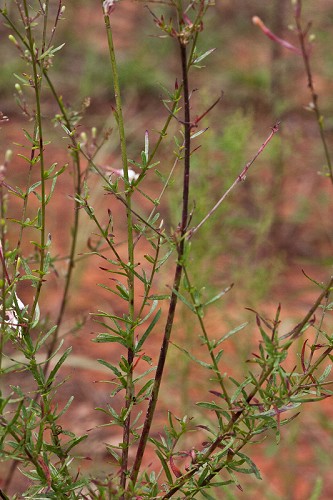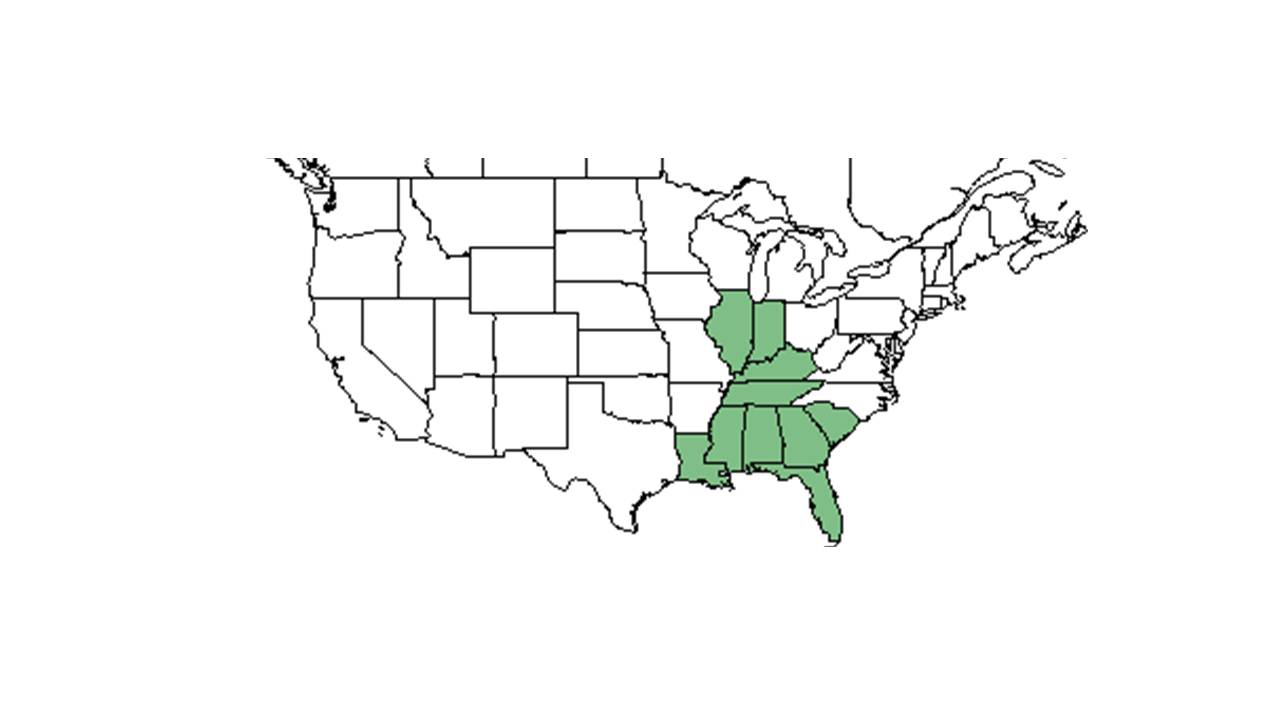Difference between revisions of "Oenothera filipes"
Lsandstrum (talk | contribs) |
|||
| (11 intermediate revisions by 5 users not shown) | |||
| Line 17: | Line 17: | ||
| range_map_caption = Natural range of ''Oenothera filipes'' from USDA NRCS [http://plants.usda.gov/core/profile?symbol=OEFI3 Plants Database]. | | range_map_caption = Natural range of ''Oenothera filipes'' from USDA NRCS [http://plants.usda.gov/core/profile?symbol=OEFI3 Plants Database]. | ||
}} | }} | ||
| − | Common name: | + | Common name: threadstalk gaura<ref name=weakley>Weakley, A.S. 2020. Flora of the Southeastern United States. Edition of 20 October 2020. University of North Carolina at Chapel Hill, Chapel Hill, North Carolina.</ref> |
==Taxonomic notes== | ==Taxonomic notes== | ||
| − | Synonyms: ''Gaura filipes'' Spach; ''Gaura filipes'' var. ''filipes''; ''Gaura filipes'' var. ''major'' Torrey & A. Gray | + | Synonyms: ''Gaura filipes'' Spach; ''Gaura michauxii'' Spach<ref name=weakley/> |
| + | |||
| + | Varieties: ''Gaura filipes'' var. ''filipes''; ''Gaura filipes'' var. ''major'' Torrey & A. Gray: <ref name=weakley/> | ||
==Description== | ==Description== | ||
| Line 26: | Line 28: | ||
''Oenothera filipes'' is a perennial herbaceous species. | ''Oenothera filipes'' is a perennial herbaceous species. | ||
| − | "Usually coarse, branched annuals or perennials. Leaves mostly alternate. Inflorescence terminal, spike-like, with or without axillary branches from upper leaves or bracts. Petals white to pink; stigmas 3-4 lobed. Fruit woody, indehiscent." <ref name=rad> Radford, Albert E., Harry E. Ahles, and C. Ritchie Bell. Manual of the Vascular Flora of the Carolinas. 1964, 1968. The University of North Carolina Press. 754-5. Print.</ref> | + | "Usually coarse, branched annuals or perennials. Leaves mostly alternate. Inflorescence terminal, spike-like, with or without axillary branches from upper leaves or bracts. Petals white to pink; stigmas 3-4 lobed. Fruit woody, indehiscent."<ref name=rad> Radford, Albert E., Harry E. Ahles, and C. Ritchie Bell. Manual of the Vascular Flora of the Carolinas. 1964, 1968. The University of North Carolina Press. 754-5. Print.</ref> |
| − | "Plant to 1.5 m tall, stems pubescent. Leaves linear, elliptic or narrowly lanceolate, to 6 cm long and 6 mm wide, pubescent, glabrous, or puberulent, acute, coarsely toothed to undulate, attenuate; sessile or subsessile. Inflorescence diffusely branched, the branches uncinulate. Spelas and petals 4-7 mm long; anthers 1.6-2.5 mm long styles exerted 5-7 mm. fruits acutely 4-angled, ovoid, 3.5-4 mm long, 3-3.5 mm broad, minutely uncinulate to almost glabrous; pedicels 2-3 mm long, uncinulate."<ref name=rad/> | + | "Plant to 1.5 m tall, stems pubescent. Leaves linear, elliptic, or narrowly lanceolate, to 6 cm long and 6 mm wide, pubescent, glabrous, or puberulent, acute, coarsely toothed to undulate, attenuate; sessile or subsessile. Inflorescence diffusely branched, the branches uncinulate. Spelas and petals 4-7 mm long; anthers 1.6-2.5 mm long styles exerted 5-7 mm. fruits acutely 4-angled, ovoid, 3.5-4 mm long, 3-3.5 mm broad, minutely uncinulate to almost glabrous; pedicels 2-3 mm long, uncinulate."<ref name=rad/> |
==Distribution== | ==Distribution== | ||
| + | ''O. filipes'' ranges from South Carolina west to Tennessee and southern Indiana, south to northeast Florida and eastern Louisiana.<ref name=weakley/> | ||
| + | |||
==Ecology== | ==Ecology== | ||
===Habitat=== <!--Natural communities, human disturbed habitats, topography, hydrology, soils, light, fire regime requirements for removal of competition, etc.--> | ===Habitat=== <!--Natural communities, human disturbed habitats, topography, hydrology, soils, light, fire regime requirements for removal of competition, etc.--> | ||
| − | ''O. filipes'' occurs in dry or well drained sandy soils and sandy loam. <ref name="FSU Herbarium">Florida State University Robert K. Godfrey Herbarium database. URL: [http://herbarium.bio.fsu.edu http://herbarium.bio.fsu.edu]. Last accessed: June 2014. Collectors: Loran C. Anderson, Gary R. Knight, John B. Nelson, Robert K. Godfrey, E. Tyson, R. D. Houk. Ann F. Johnson, Wilson Baker, R. Komarek, MacClendons, and G. Wilder. States and Counties: Florida: Bay, Calhoun, Gadsden, Jackson, Leon, Liberty, Okaloosa, Santa Rosa, Wakulla, and Walton. Georgia: Thomas.</ref> It seems to be most common in areas that receive full sun or are only | + | ''O. filipes'' occurs in dry or well drained sandy soils and sandy loam.<ref name="FSU Herbarium">Florida State University Robert K. Godfrey Herbarium database. URL: [http://herbarium.bio.fsu.edu http://herbarium.bio.fsu.edu]. Last accessed: June 2014. Collectors: Loran C. Anderson, Gary R. Knight, John B. Nelson, Robert K. Godfrey, E. Tyson, R. D. Houk. Ann F. Johnson, Wilson Baker, R. Komarek, MacClendons, and G. Wilder. States and Counties: Florida: Bay, Calhoun, Gadsden, Jackson, Leon, Liberty, Okaloosa, Santa Rosa, Wakulla, and Walton. Georgia: Thomas.</ref> It seems to be most common in areas that receive full sun or are only partially shaded.<ref name="FSU Herbarium"/> It can be found in longleaf pine flatwoods or sandhills, scrub oak barrens, pine-oak woodlands, and limestone glades.<ref name="FSU Herbarium"/> However, it can also appear in areas of disturbed habitat, including roadsides and common use recreational areas.<ref name="FSU Herbarium"/> ''O. filipes'' responds negatively to soil disturbance by agriculture in Southwest Georgia.<ref>Kirkman, L.K., K.L. Coffey, R.J. Mitchell, and E.B. Moser. Ground Cover Recovery Patterns and Life-History Traits: Implications for Restoration Obstacles and Opportunities in a Species-Rich Savanna. (2004). Journal of Ecology 92(3):409-421.</ref> |
| − | Associated species include ''Pinus palutris, Solidago, Gaillardia, Polianthes, Berchemia, Dichromema, Setaria, Hedyotis, Schoenus nigricans, Muhlenbergia carpillaris,'' and ''Quercus laevis''. <ref name="FSU Herbarium"/> | + | Associated species include ''Pinus palutris, Solidago, Gaillardia, Polianthes, Berchemia, Dichromema, Setaria, Hedyotis, Schoenus nigricans, Muhlenbergia carpillaris,'' and ''Quercus laevis''.<ref name="FSU Herbarium"/> |
===Phenology=== <!--Timing off flowering, fruiting, seed dispersal, and environmental triggers. Cite PanFlora website if appropriate: http://www.gilnelson.com/PanFlora/ --> | ===Phenology=== <!--Timing off flowering, fruiting, seed dispersal, and environmental triggers. Cite PanFlora website if appropriate: http://www.gilnelson.com/PanFlora/ --> | ||
| − | + | This species flowers from April through July.<ref name=weakley/> | |
| − | This species | ||
===Seed dispersal=== | ===Seed dispersal=== | ||
| − | This species disperses by gravity. <ref>Kirkman, L. Katherine. Unpublished database of seed dispersal mode of plants found in Coastal Plain longleaf pine-grasslands of the Jones Ecological Research Center, Georgia.</ref> | + | This species disperses by gravity.<ref>Kirkman, L. Katherine. Unpublished database of seed dispersal mode of plants found in Coastal Plain longleaf pine-grasslands of the Jones Ecological Research Center, Georgia.</ref> |
<!--===Seed bank and germination===--> | <!--===Seed bank and germination===--> | ||
===Fire ecology=== <!--Fire tolerance, fire dependence, adaptive fire responses--> | ===Fire ecology=== <!--Fire tolerance, fire dependence, adaptive fire responses--> | ||
| − | This species has been found in habitat that is often maintained by fire. <ref name="FSU Herbarium"/> | + | This species has been found in habitat that is often maintained by fire.<ref name="FSU Herbarium"/> Populations of ''Oenothera filipes'' have been known to persist through repeated annual burns.<ref>Robertson, K.M. Unpublished data collected from Pebble Hill Fire Plots, Pebble Hill Plantation, Thomasville, Georgia.</ref><ref>Platt, W.J., R. Carter, G. Nelson, W. Baker, S. Hermann, J. Kane, L. Anderson, M. Smith, K. Robertson. 2021. Unpublished species list of Wade Tract old-growth longleaf pine savanna, Thomasville, Georgia.</ref> |
<!--===Pollination===--> | <!--===Pollination===--> | ||
| − | <!--=== | + | <!--===Herbivory and toxicology===--><!--Common herbivores, granivory, insect hosting, poisonous chemicals, allelopathy, etc.--> |
<!--===Diseases and parasites===--> | <!--===Diseases and parasites===--> | ||
| − | |||
| − | == | + | ==Conservation, cultivation, and restoration== |
| + | |||
| + | ==Cultural use== | ||
| + | Evening-Primroses can be used as a potherb for their asparagus-like quality of greens, and Native Americans would use the pith to make soup. In England, there was a problem of using the leaves as a tea filler.<ref> Fernald, et al. 1958. Edible Plants of Eastern North America. Harper and Row Publishers, New York.</ref> | ||
| + | |||
==Photo Gallery== | ==Photo Gallery== | ||
<gallery widths=180px> | <gallery widths=180px> | ||
Latest revision as of 14:19, 26 May 2023
| Oenothera filipes | |
|---|---|

| |
| Photo by John R. Gwaltney, Southeastern Flora.com | |
| Scientific classification | |
| Kingdom: | Plantae |
| Division: | Magnoliophyta - Flowering plants |
| Class: | Magnoliopsida – Dicotyledons |
| Order: | Myrtales |
| Family: | Onagraceae |
| Genus: | Oenothera |
| Species: | O. filipes |
| Binomial name | |
| Oenothera filipes (Spach) W.L. Wagner & Hoch | |

| |
| Natural range of Oenothera filipes from USDA NRCS Plants Database. | |
Common name: threadstalk gaura[1]
Contents
Taxonomic notes
Synonyms: Gaura filipes Spach; Gaura michauxii Spach[1]
Varieties: Gaura filipes var. filipes; Gaura filipes var. major Torrey & A. Gray: [1]
Description
Oenothera filipes is a perennial herbaceous species.
"Usually coarse, branched annuals or perennials. Leaves mostly alternate. Inflorescence terminal, spike-like, with or without axillary branches from upper leaves or bracts. Petals white to pink; stigmas 3-4 lobed. Fruit woody, indehiscent."[2]
"Plant to 1.5 m tall, stems pubescent. Leaves linear, elliptic, or narrowly lanceolate, to 6 cm long and 6 mm wide, pubescent, glabrous, or puberulent, acute, coarsely toothed to undulate, attenuate; sessile or subsessile. Inflorescence diffusely branched, the branches uncinulate. Spelas and petals 4-7 mm long; anthers 1.6-2.5 mm long styles exerted 5-7 mm. fruits acutely 4-angled, ovoid, 3.5-4 mm long, 3-3.5 mm broad, minutely uncinulate to almost glabrous; pedicels 2-3 mm long, uncinulate."[2]
Distribution
O. filipes ranges from South Carolina west to Tennessee and southern Indiana, south to northeast Florida and eastern Louisiana.[1]
Ecology
Habitat
O. filipes occurs in dry or well drained sandy soils and sandy loam.[3] It seems to be most common in areas that receive full sun or are only partially shaded.[3] It can be found in longleaf pine flatwoods or sandhills, scrub oak barrens, pine-oak woodlands, and limestone glades.[3] However, it can also appear in areas of disturbed habitat, including roadsides and common use recreational areas.[3] O. filipes responds negatively to soil disturbance by agriculture in Southwest Georgia.[4]
Associated species include Pinus palutris, Solidago, Gaillardia, Polianthes, Berchemia, Dichromema, Setaria, Hedyotis, Schoenus nigricans, Muhlenbergia carpillaris, and Quercus laevis.[3]
Phenology
This species flowers from April through July.[1]
Seed dispersal
This species disperses by gravity.[5]
Fire ecology
This species has been found in habitat that is often maintained by fire.[3] Populations of Oenothera filipes have been known to persist through repeated annual burns.[6][7]
Conservation, cultivation, and restoration
Cultural use
Evening-Primroses can be used as a potherb for their asparagus-like quality of greens, and Native Americans would use the pith to make soup. In England, there was a problem of using the leaves as a tea filler.[8]
Photo Gallery
References and notes
- ↑ 1.0 1.1 1.2 1.3 1.4 Weakley, A.S. 2020. Flora of the Southeastern United States. Edition of 20 October 2020. University of North Carolina at Chapel Hill, Chapel Hill, North Carolina.
- ↑ 2.0 2.1 Radford, Albert E., Harry E. Ahles, and C. Ritchie Bell. Manual of the Vascular Flora of the Carolinas. 1964, 1968. The University of North Carolina Press. 754-5. Print.
- ↑ 3.0 3.1 3.2 3.3 3.4 3.5 Florida State University Robert K. Godfrey Herbarium database. URL: http://herbarium.bio.fsu.edu. Last accessed: June 2014. Collectors: Loran C. Anderson, Gary R. Knight, John B. Nelson, Robert K. Godfrey, E. Tyson, R. D. Houk. Ann F. Johnson, Wilson Baker, R. Komarek, MacClendons, and G. Wilder. States and Counties: Florida: Bay, Calhoun, Gadsden, Jackson, Leon, Liberty, Okaloosa, Santa Rosa, Wakulla, and Walton. Georgia: Thomas.
- ↑ Kirkman, L.K., K.L. Coffey, R.J. Mitchell, and E.B. Moser. Ground Cover Recovery Patterns and Life-History Traits: Implications for Restoration Obstacles and Opportunities in a Species-Rich Savanna. (2004). Journal of Ecology 92(3):409-421.
- ↑ Kirkman, L. Katherine. Unpublished database of seed dispersal mode of plants found in Coastal Plain longleaf pine-grasslands of the Jones Ecological Research Center, Georgia.
- ↑ Robertson, K.M. Unpublished data collected from Pebble Hill Fire Plots, Pebble Hill Plantation, Thomasville, Georgia.
- ↑ Platt, W.J., R. Carter, G. Nelson, W. Baker, S. Hermann, J. Kane, L. Anderson, M. Smith, K. Robertson. 2021. Unpublished species list of Wade Tract old-growth longleaf pine savanna, Thomasville, Georgia.
- ↑ Fernald, et al. 1958. Edible Plants of Eastern North America. Harper and Row Publishers, New York.